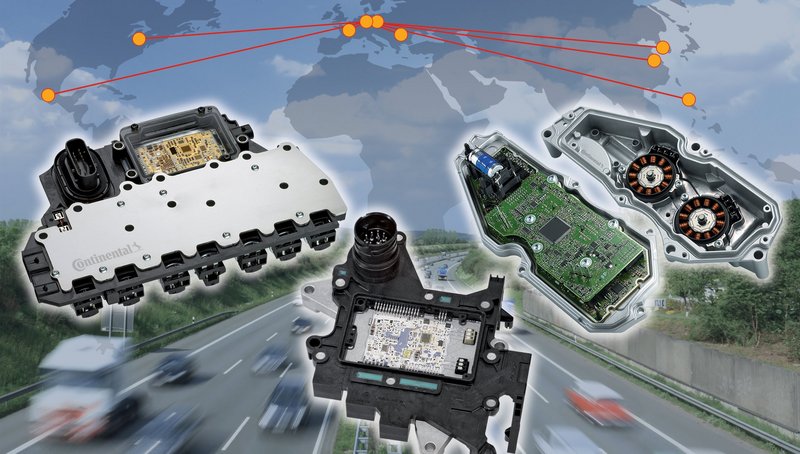The Continental Success Story of Automatic Transmission with Driving Pleasure Built In
- Pioneering work in Nuremberg: Control units for first wet and first dry double-clutch transmission from Continental
- A transmission control unit and two DC gearshift motors are combined to create a mechatronics actuator control module – a world first
Nuremberg/Regensburg, January 28, 2014. Automatic transmission and a sporty driving style were once terms you would not necessarily link. But we are now celebrating the tenth anniversary of the wide-scale launch of a technology that dispelled this apparent contradiction: the double clutch transmission (DCT). Increasing numbers of motorists, particularly in Europe and China, are thrilling to the combination of fun-filled driving and a fully automatic transmission – while using five percent less fuel than with a manual transmission. It is hardly surprising that the DCT is one of the most significant innovations in the transmission sector. Continental is one of the pioneers of this technology. "We've been involved in double-clutch control since the end of the 1990s. From the outset, we have used our expertise in managing stepped automatic and continuously variable transmissions. This meant that in 2003, we were able to make a crucial contribution to a breakthrough in this transmission technology," explains Rudolf Stark, head of the Transmission business unit.
Continental has set milestones for DCT control units
Continental's expertise is used in almost every DCT on the market. In 2013, a double-digit number of transmission control units came off the lines at the company's plants in Europe, Asia and North America, over two million of them coming from the pioneering plant in Nuremberg alone.
Continental set milestones for this technology right from the very start: firstly with a control unit fully integrated into the transmission for the world's first six-speed wet double-clutch transmission, the Volkswagen DQ250, and from 2007 on with the control unit for the first dry version of a gearbox of this type with seven speeds.
Only a year later, in an electro-mechanically actuated Getrag DCT, Continental presented a mechatronics module combining for the first time the transmission control unit and two brushless DC gearshift motors. The unit also contained sensors that record the position of the gear actuators. This made the gearshift processes even quicker and more accurate. A further advantage of this high level of functional integration was a significant reduction in the module's weight and development cost.
The transmission control unit is of vital importance
In actual fact, the systematics and construction of a double-clutch transmission date back some 70 years. At its heart is a geartrain divided into two sub-transmissions. One is responsible for the even-numbered gears and the other for the odd-numbered ones. Each sub-transmission is connected to the engine flywheel via its own clutch. The clutch that lies in the flow of force of the gear that has been selected is engaged, while the other one remains disengaged.
Generally two multi-disk clutches, coated with transmission fluid, are used for the "wet" double clutch transmission. The fluid cools the clutch and also lubricates the wheel set. Conversely, "dry" DCTs operate with two dry-running friction-disk clutches. These are chiefly used solely in combination with engines with up to approximately 250 Nm torque. This is because without cooling fluid, it is difficult to dissipate the heat given off at higher levels of performance when the vehicle is shifting gear and pulling away.
With the one clutch disengaging in the same measure as the other one engages, it is possible to shift gears without any interruption in traction. The transmission control unit is crucially important in this process. Depending on what the driver's performance requirement is, the control unit selects the right gear stage at lightning speed and manages the clutches and corresponding gearshift actuator so that the gear change is carried out promptly yet comfortably. This requires electronics that are not just high-performance but also heavy-duty. They must, after all, ensure that the gearshift processes perform with consistent uniformly throughout the service life of the vehicle.
Continental is continuing to invest further in DCT technology
Continental has succeeded in meeting such demanding requirements on a sustained basis. The control unit and its fully automated production process were developed at Continental's main plant for transmission control in Nuremberg. Up to 100 different semiconductor components are used per module – in addition to many other sensor and mechatronic components. These components are positioned on a gold surface and connected by means of gold wires. One wire is three times thinner than a human hair. As it is not possible to process such fine structures manually, Continental employs bonders that carry out more than 100 work steps per second. The plants in Romania, Mexico, China, and Korea making up the global production network all use exactly the same manufacturing process.
Continental has once again stepped up advanced development of control unit technology, putting a new test and development center into operation in Nuremberg at the beginning of last year. The new facilities make it possible not only to test the functioning of the control electronics but also to test how they interact with the hydraulic or electro-mechanical actuator. This enables even more precise fine tuning of the system.
Ideal for use in hybrid drives
Until now mainly passenger cars were fitted with a double-clutch transmission. Such transmissions are, however, increasingly being installed in commercial vehicles and agricultural implements as well. It has even made inroads into two-wheeled vehicles. The DCT is an ideal teammate for an electrified drive system: Thanks to the system design with two sub-transmissions, it is possible not merely to position the electric motor between the engine and transmission; it can also be connected to one or both wheel sets with a switchable coupling. With this versatility, a further chapter in the success story of this innovative transmission type is sure to be written.

Simone Geldhäuser
Head of Media Relations, Spokesperson Finance, Business and Technology
Vitesco Technologies

